Beaufort is a village and community located in the historic county of Breconshire. The settlement arose on the boundary of two parishes, Llangattock in Breconshire, and Aberystruth in Monmouthshire on the 1779 establishment of the Beaufort Iron Works by Edward and Jonathan Kendall, after whom the new settlement was first named. The village’s name derives from the fact that much of the local land was originally owned by the Duke of Beaufort. The border between Beaufort and Ebbw Vale itself is considered to be the Ebbw River which passes close to St David’s Church. Beaufort was transferred to the county of Monmouthshire in 1888, but for many years afterwards was referred to as Beaufort, Breconshire. The men of Beaufort, and neighbouring Rassau, who fell during all wars are commemorated on a modern war memorial, which is situated in Bethesda Church Memorial Garden, at Beaufort Rise, Beaufort. The memorial has no names as it was felt that it would be too easy to miss out people, which is understandable. However, there are several war memorials locally which do commemorate the fallen by name.
This webpage commemorates the known men and women of Beaufort who fell during the Second World War. Apologies if anyone is missing from this page, but amendments and additions can easily be made.
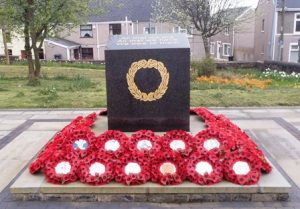
World War Two, 1939-1945
Ivor Beynon, Private, 14531159, The Queen’s Royal Regiment (West Surrey). Ivor was the son of Ivor and Mary Ann Beynon, of Rassau. He enlisted into the South Wales Borderers, but on 4 February 1943 was among a number of men from the regiment transferred to the 1st Battalion, The Queen’s Royal Regiment (West Surrey). The 1st Battalion was serving in British India on the outbreak of the Second World War but did not see action until 1942 against the Imperial Japanese Army. The 1st Queens fought in the Burma Campaign throughout the war as part of the 33rd Indian Infantry Brigade, 7th Indian Infantry Division. After extensive training, in December 1943 the 7th Division took part in an offensive in Arakan, the coastal province of Burma and advanced down the Kalapanzin River valley. In February 1944, Japanese troops infiltrated through the division’s front and but were beaten off. On the following month the Japanese launched a major offensive, so the 7th Division moved to Dimapur, and took part in the Battle of Kohima. Ivor was killed in action near Kohima on 11 May 1944. The 20-year-old has no known grave and is commemorated on the Rangoon Memorial, Myanmar.
William Price Bowen, Gunner, 2065899, Royal Artillery. William was born at Beaufort in 1919, the son of Evan Thomas Bowen and Elizabeth Bowen (nee Price). By 1939 the family was residing at Garden Village, Llanelli, where his father Evan worked as an estate repairer on the Stradey Castle Estate and was a Special Constable in the town. William enlisted into the Royal Artillery soon after the outbreak of war and was posted to the 484th (Carmarthenshire) Battery, 4th Searchlight Regiment, Royal Artillery. The unit had been formed from a number of men from the Carmarthen Fortress Engineers, a Territorial Army unit, with its HQ at Llanelli. The unit was mobilised on 24 August 1939, sending one Company to the East and West Blockhouses at Angle, Pembrokeshire, overlooking the anchorage at Milford Haven, and its second Company to searchlight positions at Bonvilston, near Cowbridge. In May 1940, the 2nd Company, at Bonvilston, became 484 (Carmarthenshire) Searchlight Company, RE, and then in August the Company was transferred to the Royal Artillery. The battery was moved to Swansea during the Blitz and remained there until being relieved at the end of September 1940, moving to Plymouth. In November the battery embarked for Malta, arriving via Egypt on 8 January 1941, and took up positions on the island, which had been under air attack since the start of the war. Large scale air raids began in earnest in February 1941, mostly by Luftwaffe units, then later by the Italians. William was killed during another day of heavy air attacks on 6 April 1942. The 22-year-old is buried in Pembroke Military Cemetery, Malta. His parents had by then moved back to 10, Wesley Place, Beaufort.
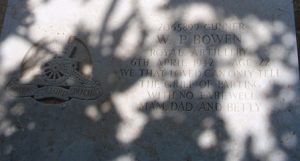
John Henry Bull, Private, 4037495, King’s Shropshire Light Infantry. John was the son of John Bull and Elizabeth Lavinia Bull (nee Freebury), of 3, Cross Row, Rassau. He enlisted into the army and was posted to the 4th Battalion, King’s Shropshire Light Infantry. The Battalion was a Territorial Army unit and was attached to the 159th Infantry Brigade, 53rd (Welsh) Division at the outbreak of war. On 17 May 1942, the 4th KSLI, along with the brigade, were transferred to become the motorised infantry element of the 11th Armoured Division and spent the next two years training and preparing for Operation Overlord. The Division landed on Juno Beach on 13 June 1944 and took part in several major action soon afterwards, which led to the break-out from the Normandy beachhead. It then took part in the drive through Northern France into Belgium over the coming weeks. The 11th Armoured liberated L’Aigle on 23 August and crossed the Seine on 30 August. Moving some 60 miles that night, the Division liberated Amiens on 1 September before advancing to Lens, then Tournai, and then pushed towards the strategically important Belgian port of Antwerp, which it liberated on 4 September. Two days later, on 6 September 1944, the Division tried to establish a bridgehead over the Albert Canal but failed due to a heroic German defence. John was killed in action during the attack that day. The 29-year-old is buried in Schoonselhof Cemetery, Antwerp. His father, John Bull, had been killed during the Great War.
Leslie Alfred Bull, Private, 1458889, South Wales Borderers. Leslie was born on 21 January 1925, the son of Edgar Alfred Bull and Florence May Bull (nee Boulter), of Beaufort. He lodged at Somerset Terrace, Ebbw Vale prior to the war and worked as a conveyor operator. Leslie enlisted into the South Wales Borderers in 1943 and was posted to the 1st Battalion, South Wales Borderers. The original battalion had been lost in North Africa during the fall of Tobruk in June 1942, so a new battalion was formed from the 4th Monmouth’s before being despatched to Palestine with the 1st Armoured Division in October 1945. Leslie was killed in Palestine on 3 November 1945, soon after the battalion arrived. The 20-year-old was buried in Khayat Beach War Cemetery, Israel.
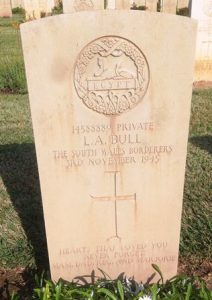
Richard Uriah James Churchill, Private, 3913483, South Wales Borderers. Richard was the son of Uriah James Churchill and Harriet Churchill, of Beaufort. He married Margaret Elizabeth Ann Price in 1938 and the couple lived with Richard’s parents at 3, Radford Terrace, Beaufort. Richard worked as a butcher’s assistant prior to enlisting into the 6th Battalion, South Wales Borderers. The battalion was raised at Glanusk Park in July 1940 and began infantry training. Richard was killed at Swansea on 19 February 1941, during the first night of a three-night Blitz upon the town. The body of the 27-year-old was brought home and he was buried in Ebenezer Methodist Burial Ground, Beaufort.
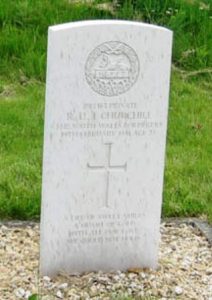
Mervyn Davies, Private, 1093097, Pioneer Corps. Mervyn was the son of Emlyn Thomas Davies and Mary Ann Davies (nee Holcombe), of Ebbw Vale. He married Gladys May Jones in 1930 and the couple set up home at Rassau. Mervyn enlisted into the army and was posted to the Pioneer Corps. Little else is known of his service, but he died at home on 26 June 1945. The 34-year-old was buried in Ebbw Vale Cemetery.
William Ricard Davies, Sergeant, 536210, Royal Air Force. William was the son of William and Florence A. Davies, of Beaufort. He enlisted into the Royal Air Force prior to the war and was posted to 217 Squadron, Royal Air Force. The squadron had reformed in 1937 as part of RAF Coastal Command, equipped with Avro Anson’s. Following the outbreak of war the squadron moved to RAF St Eval, in Cornwall, where it re-equipped with the Bristol Beaufort torpedo bomber. The Squadron carried out anti-shipping and mine-laying missions, taking part in the operations to intercept the German battleships Scharnhorst and Gneisenau as they made their daring Channel Dash from Brest for Germany. In February 1942, the squadron moved briefly to RAF Skitten and then RAF Leuchars in Scotland, where they began operations, but in May 1942 the Squadron was moved to Ceylon, via Gibraltar and Malta. The Squadron spent two months in Malta, carrying out anti-shipping attacks across the Mediterranean, suffering terrible losses, and the survivors eventually arrived in Ceylon in July 1942, with no aircraft. The Squadron was initially based at RAF Minneriya, in the east central part of Ceylon, where it began to receive Lockheed Hudson’s. William took ill in Ceylon in September 1942 and was transferred to hospital in India, where he died of tuberculosis on 25 February 1943. The 27-year-old is buried in Kirkee War Cemetery, India.
James Henry Lloyd Edwards, Sergeant, 1380763, Royal Air Force Volunteer Reserve. James was born on 13 September 1922, the son of Joseph Edwards and Clara Edwards (nee Woods), of Awelfryn, Hospital Road, Beaufort. He was a member of the St Johns Ambulance and an ARP Warden prior to enlisting into the Royal Air Force Volunteer Reserve and after training as a Wireless Operator/ Air Gunner was posted to 42 Operational Training Unit, which was based at RAF Ashbourne, in Derbyshire. On 6 April 1943, James was flying aboard a Bristol Blenheim V, Serial BA741, on a training flight in Scotland, when the aircraft struck a hill at Gameshope, near Tweedsmuir, Peebles in low cloud, killing James, his pilot and their navigator. James was 20 years old when he was killed that day. His body was recovered from the wreckage and brought home for burial in St. David’s Churchyard, Beaufort. His brother, Leslie Cosmo Edwards and William George Edwards also fell during the war.
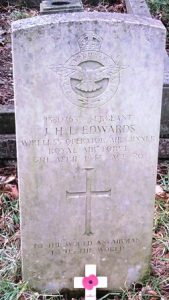
Leslie Cosmo Edwards, DFC, Flying Officer, 45719, Royal Air Force. Leslie was the son of Joseph Edwards and Clara Edwards (nee Woods), of Awelfryn, Hospital Road, Beaufort. He enlisted into the Royal Air Force and after training as an Observer was posted to 21 Squadron, Royal Air Force, as a Flight Sergeant. On the outbreak of the was the squadron was converting to the Bristol Blenheim IV, so was not fully operational, flying reconnaissance missions, but by May 1940 it began carrying out daylight attacks against advancing German infantry columns, during the Battle of France. From June to October 1940 the squadron operated from RAF Lossiemouth, attacking German shipping off the coast of Norway, before moving back to Norfolk where it began low-level attacks on enemy shipping. Leslie was awarded the Distinguished Flying Cross in April 1941 and on the following month, Leslie was granted a commission as Pilot Officer, before being transferred to 60 Squadron, Royal Air Force. The squadron had moved to Burma in February 1941 and saw much action following the Japanese invasion of Malaya, suffering heavily. On 24 December 1941 the survivors of the Squadron sailed from Singapore on the SS Darvel to Burma, arriving in Rangoon on 1 January 1942. It was joined by the survivors of two other squadrons shortly afterwards, mustering only seven aircraft between the three squadrons. Following a number of raids on targets in Bangkok, 60 Squadron was declared non-operational and moved to Asansol, India along with 45 and 113 Squadrons, to rebuild and refit. Once in India the squadron was re-equipped with Blenheim Mk IV’s. On 23 June 1942 Leslie was flying aboard Blenheim IV, Serial Z9721, piloted by Lieutenant Leonard Beesly, which had set out to attack Japanese ships off Akyab. The ships had left by the time the Blenheim arrived, so it set to attacking the port. Leslie and his pilot were killed when the Blenheim was brought down near the target that day. Leslie was 25 years old and is commemorated on the Singapore Memorial, Kranji. His brothers, James Henry Lloyd Edwards and William George Edwards also fell during the war.
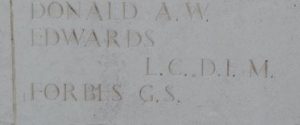
William George Edwards, Pilot Officer, 42937, Royal Air Force. William was the son of Joseph Edwards and Clara Edwards (nee Woods), of Awelfryn, Hospital Road, Beaufort. He enlisted into the Royal Air Force and after training as a Wireless Operator/Air Gunner was posted to 40 Squadron, Royal Air Force. On the eve of the declaration of war, the squadron flew its obsolete Fairey Battles to Bétheniville, in France, as part of the Advanced Air Striking Force, the air element of the BEF. In December 1939, the squadron was withdrawn from France for re-equipping with Bristol Blenheim Mk IV light bombers at RAF Wyton. On 10 May 1940, Germany invaded France and the Low Countries, and 40 Squadron began carrying out attacks on German columns and airfields as the BEF began to retreat towards Dunkirk. On 23 May 1940, William was flying aboard Blenheim IV, Serial P4909, which was attacking German columns approaching Arras, when the Blenheim was hit by Anti-Aircraft fire and crashed near Beuvry, killing William and his pilot, Wing Commander John Griffith Llewelyn. William was 30 years old when he was killed in the resulting crash. He is buried in Sailly-Labourse Communal Cemetery, France. His brothers, James Henry Lloyd Edwards, and Leslie Cosmo Edwards, also fell during the war.
Gordon Llewelyn Hamer, Fireman and Trimmer, Merchant Navy. Gordon was born at Beaufort on 23 April 1924, the son of David Edward Hamer and Elizabeth Hamer (nee Bevan). By 1939 the family was residing at 118, Seymour Road, Tottenham, and Gordon was working as a Grocer’s Assistant. He enlisted into the Merchant Navy soon afterwards and was posted aboard the SS Stockport. She had originally been built as a passenger and cargo vessel for the Great Central Railway in 1912 but was requisitioned by the Admiralty following the outbreak of World War Two to serve as a convoy rescue ship. On 21 February 1943, Stockport was sailing with Convoy ON166, when she went to the assistance of the oil tanker SS Empire Trader, which was straggling behind the convoy north of the Azores, Portugal. The helpless tanker was then torpedoed and crippled by the German submarine U-92, but SS Stockport managed to rescue all 106 of her crew. Stockport was attempting to regain the convoy on 23 February 1943, when she was torpedoed and sunk by another German submarine, U-604, and went down with all hands. Gordon was just 18 years old when he was killed that day. He has no known grave and is commemorated on the Tower Hill Memorial, London.
Walter Llewelyn Hawkins, Ordinary Telegraphist, LT/JX 360697, Royal Naval Patrol Service. Walter was born on 15 March 1923, the son of David Henry Hawkins and Alice Hawkins (nee Purser), of Beaufort. He enlisted into the Royal Navy and was initially based at HMS Pembroke I for training. Walter was then posted to the Royal Naval Patrol Service, joining the crew of HM Tug Roode Zee. She was a Dutch tug, which had been requisitioned by the Royal Navy and converted for use as a patrol ship and rescue vessel. On 24 April 1944, Roode Zee was some two miles off Dungeness when she was attacked by a high-speed German E-Boat. The Germans managed to hit the defenceless tug with a torpedo, and she exploded and sank with the loss of fifteen crew and a pilot. Walter was 21 years old when he was killed in the sinking that day. He has no known grave and is commemorated on the Lowestoft Naval Memorial, Suffolk.
James Tacey Howells, Private, 3915685, The Parachute Regiment. James was born on 7 August 1922, the son of Daniel Howells and Ida May Howells (nee Smith), of Rassau. He enlisted into the army and was posted to the 10th Battalion, Royal Welch Fusiliers. In August 1942 the battalion was converted from an ordinary infantry unit into the 6th (Royal Welch) Parachute Battalion, as part of the 2nd Parachute Brigade. The Brigade embarked for North Africa in April 1943 to prepare for operations in Sicily and Italy. The Brigades first operation was cancelled, whilst the 1st Parachute Brigade landed in Sicily where it suffered heavy casualties. In the meantime, plans were put into place for Operation Slapstick, the landings at Taranto. The 2nd Parachute Brigade left Bizerta on 8 September, the day before the Italian surrender, and landed unopposed, however James was aboard a transport ship, HMS Abdiel, which struck a mine and sank whilst entering the port on 10 September 1943, going down with the loss of fifty-eight men from the 6th Parachute Battalion. James was 21 years old when he was killed in the sinking of HMS Abdiel that day. His body was recovered from the sea, and he was buried in Bari War Cemetery, Italy.
William Stanley Hughes, Private, T/3914918, Royal Army Service Corps. William was the son of Walter Hughes and Mary Elizabeth Hughes (nee Price), of Beaufort. He enlisted into the army and was posted to the Royal Army Service Corps. Little is known of his military service, but William died in the Bedwellty district on 6 March 1942, aged 28. He was buried in Carmel Independent Chapelyard, Beaufort, but is also commemorated on the Screen Wall in Cardiff Western Cemetery.
Walter Kenneth Hurley, Stoker 2nd Class, D/KX 101041, Royal Navy. Walter was born on 21 February 1918, the son of Bert Hurley and Florence Beatrice Hurley (nee Hitchcock), of Beaufort. He enlisted into the Royal Navy soon after the outbreak of war and was posted aboard HMS Glorious. She had originally been built as a Courageous-class battlecruiser during the First World War but during the late 1920’s was converted for use as an aircraft carrier. She re-commissioned in 1930 and spent most of the coming years operating in the Mediterranean. After the start of the Second World War in 1939, Glorious spent the rest of the year unsuccessfully hunting for the commerce-raiding German cruiser Admiral Graf Spee in the Indian Ocean before returning to the Mediterranean. She was recalled home in April 1940 to support operations in Norway following the German invasion. On 7 June 1940 Glorious left Norway after taking onboard a number of aircraft from RAF units operating there and set sail for the safety of Scapa Flow. On the following day, 8 June 1940, Glorious and her two escorting destroyers, Acasta and Ardent, was spotted by the German battleships Scharnhorst and Gneisenau, which opened fire upon the helpless ships, sinking all three with the loss of over 1,500 lives. Walter was 21 years old when he was killed in the sinking of Glorious that day. He is commemorated on the Plymouth Naval Memorial, Devon.
David Morgan Jones, Pilot Officer, 63819, Royal Air Force Volunteer Reserve. David was the son of Gwyn Oswald Lewis Jones and Lilian Mary Jones (nee Morgan), of Beaufort. He enlisted into the Royal Air Force Volunteer Reserve and after training as a Pilot was posted to No. 18 Operational Training Unit, which was based at RAF Bramcote, for conversion training aboard the Vickers Wellington. On 14 March 1942, David took off from Bramcote aboard Vickers Wellington Ic, Serial T2961, on a night training exercise. The Wellington hit some trees on take-off and crashed into a building, killing all but one of the men aboard. David was 22 years old when he was killed that day. His body was recovered from the wreckage and taken home for burial in Carmel Independent Chapelyard, Beaufort. David is also commemorated on the Screen Wall at Cardiff Western Cemetery.
John Robert Jones, Flight Sergeant, 3025712, Royal Air Force Volunteer Reserve. John was the son of Robert Frank Jones and Blodwen Jones (nee Parry), of Rassau. He enlisted into the Royal Air Force Volunteer Reserve and after training as a Flight Engineer was posted to 297 Squadron, Royal Air Force. The squadron had been formed as a Parachute unit and in 1943 the squadron flew their Armstrong Whitworth Albemarle’s to Algeria to take part in Operation Husky, the invasion of Sicily, where they dropped members of the 1st Airborne, before returning to Britain the same year. The squadron then began practising towing Horsa gliders in preparation for Operation Overlord, where the Airborne would be tasked with the capture of the Caen canal and Orne River bridges, as well as the Merville Batter, which overlooked Sword Beach. The squadrons next major operation was during Operation Market Garden, where it towed 29 Horsa and 2 Waco gliders in the first wave and 24 Horsa’s in the second, all without loss. The squadron’s last mission of the war was on 24 March 1945, when thirty Halifax aircraft towed Horsa’s manned with 6th Airborne paratroopers to carry out a successful Rhine crossing. The squadron was disbanded on 1 April 1946 but reformed on 1 April 1946 at RAF Station Tarrant Rushton. John was killed here on 8 July 1946 whilst flying aboard a Halifax AVII, which crashed during take-off whilst on a supply dropping exercise. The remains of the 20-year-old were brought back home, and he was buried in Ebbw Vale Cemetery.
William Edward Jones, Private, 14205103, Sherwood Foresters (Notts and Derby Regiment). William was the son of William Thomas Jones and Alice Jones, of Beaufort. He enlisted into the army and was posted to the 5th Battalion, Sherwood Foresters (Notts and Derby Regiment). The battalion had been formed from the 2/5th Sherwood Foresters in February 1942, after the 1/5th Battalion had been lost in Malaya and joined 139 Infantry Brigade, 46th (North Midland) Division. The brigade saw service in France with the 46th Division, when it embarked for France in April 1940 to join the BEF. Poorly equipped and trained, the Division was sent, along with the 12th and 23rd Divisions, to complete their training and to help construct defences and airfields and as a result suffered heavy casualties when the Germans swept the BEF back towards Dunkirk, before the survivors were evacuated to England. The Division spent the next few years on home defence and training before being sent to North Africa in late 1942, joining the First Army, and saw action in the final stages of the Tunisia Campaign. The division did not see service in Sicily but landed at Salerno in September 1943 as part of the US Fifth Army during the initial invasion of Italy. William was killed during the attacks on the German Volturno Line, based along the River Volturno, on 13 October 1943. The 21-year-old is buried in Minturno War Cemetery, Italy.
William Lionel Jones, Sergeant, 1412377, Royal Air Force Volunteer Reserve. William was born on 11 May 1922, the son of William Jones and Sarah Jane Jones, of Rassau. He enlisted into the Royal Air Force Volunteer Reserve and after training as an Air Gunner was posted to 7 Squadron, Royal Air Force, which was a heavy bomber unit, based at RAF Oakington, in Cambridgeshire. On the night of 29 November 1942, William took off from Oakington aboard a Short Stirling Mk I, Serial R9150, which was part of a force of bombers despatched to bomb the Fiat Works in Turin. The aircraft was one of a few which successfully crossed the Alps and reached the target, before heading for home. During the return leg of the journey on the following morning, 30 November 1942, the Stirling was attacked and shot down by a German night-fighter, crashing near Pecy, some 21 miles Northeast of Melun in France, with the loss of five of her crew of seven. William was 20 years old when he was killed in the crash that morning and is buried alongside his fellow crewmen in Pecy Communal Cemetery, France.
John Malpass, Signalman, 2341452, Royal Corps of Signals. John was the son of Ernest Frank Malpass and Elizabeth Malpass, of 106, Belmont House, Ebbw Vale. He married Hilda Louvain Brown, of 101, The Rise, Beaufort in 1940. John enlisted into the Royal Corps of Signals and was posted to VI Corps Signals. Little else is presently known of his service, but John died on 21 February 1941, aged 21. He is buried in Ebbw Vale Cemetery.
James Lawrence McNamara, Lance Corporal, 5957380, Bedfordshire and Hertfordshire Regiment. James was born at Pontardawe in 1920, the son of James McNamara and Elizabeth McNamara (nee Payne). The family moved to Rassau at some time afterwards, after his father had gained a position as a Foreman Steel Smelter at Ebbw Vale. James enlisted into the army and was posted to the 1st Battalion, Bedfordshire and Hertfordshire Regiment. The battalion was stationed in the Middle East with 14th Infantry Brigade, 6th Division at the start of the war, then moved to India in 1942, after the Japanese entered the war. The battalion became part of Orde Wingate’s famous Chindit force and served in the Burma Campaign of 1944. James was probably taken ill during the campaign, which became renowned for the terrible impact of tropical diseases on the troops, and was sent back to India, where he died on 28 April 1944. The 23-year-old is buried in Gauhati War Cemetery, India.
John James Merritt, Sergeant, 1252255, Royal Air Force Volunteer Reserve. John was born at Beaufort on 28 April 1921, the son of William James Merritt and Gladys May Merritt (nee Price). He was raised with his grandparents at 134, Beaufort Hill prior to enlisting into the Royal Air Force Volunteer Reserve and trained as an Air Gunner before being posted to 51 Squadron, Royal Air Force. The squadron was a heavy bomber unit, which had begun the war dropping propaganda leaflets over Germany, using its Armstrong Whitworth Whitley aircraft. In February 1942 aircraft from the squadron carried an elite team of paratroopers and an RAF electronic engineer to Bruneval, France, to carry out a raid on a German radar installation, removing parts of a new type of radar which they took back to Britain. The squadron then transferred to Coastal Command, patrolling against U-Boats in the Bay of Biscay, before re-equipping with the Handley Page Halifax in 1942, before joining No. 4 Group RAF, and moving to RAF Snaith in East Yorkshire. On 3 April 1943, John took off from Snaith aboard a Handley Page Halifax II, Serial DT666, as part of a large force of bombers despatched to bomb targets in Essen, Germany. The raid was a success and John’s Halifax headed back for Snaith. During the early hours of the following morning, 4 April 1943, John’s Halifax was nearing Snaith and preparing for landing when a fire broke out aboard her and the aircraft crashed near Selby, killing John and two of his fellow crewmen. John was 21 years old when he was killed in the crash that morning. His body was recovered from the wreckage and brought home for burial in St. David’s Churchyard, Beaufort.
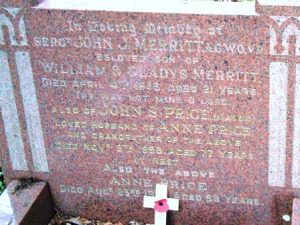
Eustace Vincent Norris, Sergeant, 1836940, Royal Air Force Volunteer Reserve. Eustace was the son of Albert Edward Norris and Catherine Bernice Maud Mary Norris (nee Sheppard), of Beaufort. He enlisted into the Royal Air Force Volunteer Reserve and after training as a Flight Engineer was posted to No. 1666 Heavy Conversion Unit, at RAF Wombleton, in Yorkshire. On 19 November 1944, Eustace took off from Wombleton aboard a Handley Page Halifax II, Serial DT735, on a training flight intended to train the crew on flying with one engine off. The aircraft was lost without a trace, presumably over the sea, that day, with all her crew. Eustace was 31 years old when he died that day. He has no known grave and is commemorated on the Runnymede Memorial, Surrey.
John Rees, Sergeant, 1317618, Royal Air Force Volunteer Reserve. John was the son of Daniel Rees and Margaret Jane Rees, of Beaufort. He enlisted into the Royal Air Force Volunteer Reserve and trained as a Pilot before being posted to 10 Squadron, RAF, which was based at RAF Melbourne, in Yorkshire. On the night of 23 May 1943, John took off from Melbourne aboard Handley Page Halifax II, Serial DT789, as part of a large bomber force of 826 aircraft despatched to destroy targets in Dortmund. The advanced Pathfinders managed to mark the target accurately, resulting in a successful raid, with much devastation being wreaked across large parts of the city and the important Hoesch steelworks were put out of action. John was crossing the North Sea, about 25 Miles Northwest of Texel, on the return leg the following morning, 24 May 1943, when his Halifax was attacked and shot down by a German night-fighter, crashing into the sea with the loss of all her crew. John was 19 years old when he was killed that morning. His body was later recovered from the sea, and he was buried in Brunsbuettelkoog Cemetery, Germany, alongside five of his fellow crewmen. Their graves were exhumed after the war and on 18 June 1947 the men were buried side by side in Kiel War Cemetery, Germany.
Ivor Sams, Fusilier, 6914941, Royal Northumberland Fusiliers. Ivor was the son of Frederick Sams and Elsie Sams (nee Joyce), of 25, Rhys Street, Pontypridd. He married Alice Joyce, of 53, Beaufort Terrace, Beaufort, in 1941. Ivor enlisted into the army and was posted to the 4th Battalion, Royal Northumberland Fusiliers. The battalion was attached to the 50th (Northumbrian) Division and served with the division in France and Belgium from January to June 1940, seeing considerable action on the Ypres-Comines Canal. After returning from Dunkirk, the battalion came under command of Home Forces until April 1941, when it was transferred to the Reconnaissance Corps and redesignated as the 50th Battalion, Reconnaissance Corps, re-joining the 50th Division. It was sent to North Africa with the division in June 1941, and spent its early months there attached to the 150th Infantry Brigade, before joining the 22nd Armoured Brigade. The battalion returned to Britain in June 1942, but Ivor remained in North Africa, probably attached to another unit. He died in North Africa on 12 November 1944, aged 25. Ivor has no known grave and is commemorated on the Alamein Memorial, Egypt.
David William Samuel, Gunner, 11051203, Royal Artillery. David was born on 8 January 1905, the son of Enoch Samuel and Laura Samuel, of 76, The Rise, Beaufort. He married Charlotte Evelyn Davies in 1937 and the couple set up home at 90, Back, Nantyglo, where David worked as a steelworker. He enlisted into the army following the outbreak of war and was posted to the 433rd Battery, 131st Light Anti-Aircraft Regiment, Royal Artillery. David died in Essex on 19 May 1945, aged 40. His body was brought back home, and he was buried in Hermon Baptist Burial Ground, Nantyglo.
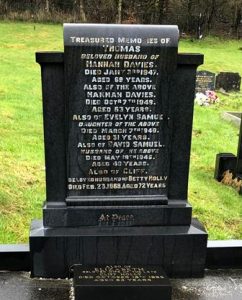
William George Spicer, Private, 3914184, South Wales Borderers. William was born on 20 July 1910, the son of Charles Eavis Spicer and Eleanor Mary Spicer (nee Morgan), of 7, Armoury Terrace, Ebbw Vale. He married Florence May Phillips in 1933, and the couple lived at Beaufort. William enlisted into the 1st Brecknockshire Battalion, South Wales Borderers following the outbreak of war. The battalion formed and mobilised at Gwernyfed Park Camp soon after the outbreak of war, before sending two companies to Cardiff and Newport Docks for coastal garrison duties. The battalion moved to Liverpool at the end of 1940, where it was visited by HM King George V. In February 1941 the battalion moved to Blenheim Barracks in Aldershot, followed by further moves to Petworth Park, Chichester, then to Pondbury Barracks in Dorset. More moves followed during the coming years, then by January 1944 the battalion moved to the Isle of Wight, where it remained until landing in Normandy following the initial D-Day invasion. The battalion took part in the Battle of Bayeux and the Battle of Caen, but was disbanded on 14 July 1944, the men being distributed between the 2nd and 3rd battalions of the Monmouthshire Regiment. William was serving with one of the Monmouthshire battalions when he was killed on 22 August 1944. The 34-year-old is buried in Ranville British Cemetery, France.
Sydney Frederick Vaughan, Engine Room Artificer 5th Class, D/MX.802130, Royal Navy. Sydney was born on 4 October 1927, the son of Sydney George Vaughan and Winifred Vaughan (nee Lloyd), of Beaufort. He enlisted into the Royal Navy at some time around the end of the war and after completing his training was posted aboard HM Submarine Tantalus. She had been built by Vickers Armstrong at Barrow-in-Furness and launched in February 1943. After her commissioning she was despatched to the Far East to carry out strikes against Japanese shipping. Tantalus had a successful career in the Pacific, returning to Britain safely after the end of the war, to continue in service based from her new home at Portsmouth. Sydney was found dead, hanging by the neck at Portsmouth on 20 January 1947. The body of the 19-year-old was brought home and he was buried in Ebbw Vale Cemetery,
Arthur Watkins, Driver, T/215959, Royal Army Service Corps. Arthur was the son of William James Watkins and Margaret Ann Watkins (nee Winstone), of 29, Frost Road, Beaufort. He enlisted into the army and was posted to the Royal Army Service Corps, as a Driver. Little else is known of Arthur’s war, but he must have stayed in Germany as part of the British Army on the Rhine after the war. He died at Brunswick on 23 July 1946, aged 27, and was buried in Brunswick. On 28 April 1947 he was re-interred in Hanover War Cemetery, Germany.
Thomas Weaver, Corporal, 3909913, South Wales Borderers. Thomas was the son of Benjamin Mark Weaver and Eugenia Weaver (nee Price), of 18, Primitive Place, Beaufort. He enlisted into the army and was posted to the 2nd Battalion, South Wales Borderers. The battalion was a regular army unit and was in Northern Ireland at the outbreak of war. In December 1939 the battalion left Northern Ireland and joined the 148th Infantry Brigade, 49th (West Riding) Infantry Division, then in April 1940 transferred to the 24th Guards Brigade (Rupertforce), before landing in Norway to take part in the Norwegian Campaign. The battalion was among the first British troops to see action against the Germans during the war. The Norway campaign ultimately failed, and the brigade was evacuated back to Britain. The 2nd SWB then transferred to the 37th Independent Infantry Brigade, which was redesignated as the 7th Infantry Brigade the following day and remained with the brigade until 1 March 1944 when it transferred to the newly created 56th Independent Infantry Brigade, together with the 2nd Essex and the 2nd Gloucester’s, before beginning training for the invasion of Normandy. The battalion became the only Welsh battalion to take part in the Normandy landings on 6 June 1944, landing at Gold Beach under command of the 50th (Northumbrian) Infantry Division. Thomas survived the landings on D-Day, but was killed two months later, during the Battle of the Falaise Gap, on 13 August 1944. The 25-year-old is buried in Banneville-La-Campagne War Cemetery, France.
Clifford Wilcox, Corporal, 5255688, Royal Hampshire Regiment. Clifford was the son of George Henry Wilcox and Sarah Ann Wilcox (nee Bevan), of Beaufort. He married Edyth Date, of 5, Bryngwyn Road, Beaufort, in 1943. Clifford enlisted into the army and was posted to the 2nd Battalion, Royal Hampshire Regiment. The battalion was a regular army unit which had fought in France with the BEF in 1940 and saw heavy fighting on the Maginot Line before withdrawing to Dunkirk for evacuation. The battalion then spent two years on home defence, training and preparing for a potential German invasion. In November 1942, the battalion sailed for North Africa attached to the 1st Guards Brigade, 78th Infantry Division, to take part in Operation Torch. After disembarking at Algiers on 21 November to join the First Army, the 2nd Hampshire’s moved to Tebourba where it undertook a prolonged period of heavy fighting, during a rear-guard action which saw Major Wallace Le Patourel of the battalion awarded the Victoria Cross for his gallantry in leading counterattacks against the enemy. After the fall of Tunis on 13 May 1943, the 2nd Hampshire’s joined the 128th (Hampshire) Brigade, 46th Infantry Division and took part in the invasion of mainland Italy, landing at Salerno in September 1943. Clifford was killed during the attacks on the Gothic Line on 30 August 1944. The 29-year-old is buried in Montecchio War Cemetery, Italy.
Thomas James William Wilcox, Gunner, 1093176, Royal Artillery. Thomas was born on 26 November 1914, the son of William Henry Wilcox and Emily Wilcox (nee Hill), of Beaufort. He married Iris May Bull, of Beaufort Hill, Beaufort, in 1936. Thomas worked as a steelworker prior to the war. He enlisted into the army and was posted to the 75th Field Regiment, Royal Artillery. The regiment had served in France with the BEF in 1940 and after evacuation from Dunkirk was put on home defence duties before embarking for North Africa in 1943 to take part in the Tunisian campaign. Thomas died in North Africa on 2 July 1943, after the surrender of the Afrika Korps. The 27-year-old is buried in La Reunion War Cemetery, Algeria.
Granville John Williams, Private, 3910930, Durham Light Infantry. Granville was the son of William Williams and Jane Williams (nee Redden), of Beaufort. He enlisted into the army and was posted to the 9th Battalion, Durham Light Infantry. The battalion was a Territorial Army unit, attached to the 151st Infantry Brigade, 50th (Northumbrian) Infantry Division, and was deployed to France with the BEF in January 1940, moving to the Belgian border, around the city of Lille. In May 1940, German armoured forces broke through French positions east of the BEF, and moved rapidly across its rear, separating it from the main French armies. The 50th Division took part in a counterattack which helped slow the German advance on Dunkirk, before withdrawing and being evacuated from Dunkirk itself. The 50th Division remained in Britain until 22 April 1941, when it was sent to the Middle East, firstly to Cyprus, then in Iraq, Syria, and Egypt before joining the Eighth Army in Libya in May 1942. The Division took part in the Battle of Gazala in May 1942, becoming cut off from the coast road to Tobruk, so took part in a well-planned manoeuvre to break through the Italian forces to their front, then circle south before turning east and reaching Egypt. The Division then took part in a rear-guard stand at Mersa Matruh in June, which saw the 9th DLI suffer heavy losses in an action which saw one man of the battalion, Private Adam Herbert Wakenshaw, gain the award of the Victoria Cross. The Division then took part in the Second Battle of El Alamein in October, followed by Operation Supercharge soon afterwards. The Division then took part in the Tunisian Campaign, Helping break the Mareth Line. Following the surrender of the Afrika Korps on 12 May 1943, the Allies turned their attention to Italy. The first stage of the offensive on Italy was Operation Husky, the Allied invasion of Sicily. On 10 July, the 151st Brigade landed in the Gulf of Noto, at Avola; its objective was the hills above the landing beaches. Granville was killed at Sicily six days later, on 16 July 1943. The 25-year-old is buried in Catania War Cemetery, Sicily, Italy.
Sidney George Williams, Lance Corporal, 2737210, Welsh Guards. Sidney was the son of John Williams and Elizabeth Williams (nee Hammond), of Beaufort. He married Ethel Elizabeth Lilian Butcher at Brentford in 1942, and the couple set up home at Beaufort. Sidney had enlisted into the Welsh Guards and was posted to the 3rd Battalion, Welsh Guards. The battalion had been formed at Beavers Camp, Hounslow on 24 October 1941, before sailing for North Africa on 5 February 1943, landing in Algiers. The battalion then moved to El Aroussa, twenty miles south of Medjez El Bab, where it joined the 1st Guards Brigade. The 3rd Welsh Guards then took part in the drive towards the Mareth Line, a series of fortifications on the Southern boundary of Tunisia, before taking part in the capture of the hills to the North of the Fondouk Gap, where the battalion saw heavy fighting. The 1st Guards Brigade then took part in the advance towards Hammam Lif, attacking and capturing the town before the surrender of the Afrika Korps. The 3rd Welsh Guards spent the rest of the year in Algeria, before moving to Italy early in 1944, to join the great drive to push the occupying Germans out of the country. The Battalion was ordered to relieve the 2nd/4th Hampshire Regiment and hold Monte Cerasola, which it did in terrible conditions, fighting off a series of German counterattacks. The Battalion then garrisoned a part of the town of Cassino, before joining the advance towards the ancient town of Acre on the road to Rome. The road north ran through Monte Oria which lay on the right and Monte Piccolo and Monte Grande on the left. The 3rd Welsh Guards assaulted Acre, suffering over 300 casualties in a fierce battle against the desperate German defenders. Sidney was killed here on 27 May 1944. The 23-year-old is buried in Cassino War Cemetery, Italy.
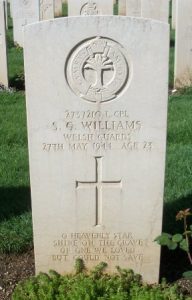
Mary Amos Williamson, Leading Aircraftwoman, 454665, Women’s Auxiliary Air Force. Mary was the daughter of Rees and Agnes Price, of 4, Somerset Terrace, Waengoch. She had married Frederick Charles Williamson, of Quinton, Birmingham at some time after the outbreak of war. Mary served with the Women’s Auxiliary Air Force, and was attached to 81 (Signals) Wing, based at RAF Great Witcombe, Gloucester. The camp was associated with the nearby radio stations at Birdlip and Winstone as well as the radar station on Leckhampton Hill. Mary took ill around Christmas 1943 and was taken to Stow Hill Hospital, at Newport, where she died of pneumonia on 5 January 1944. The body of the 21-year-old was brought home and she was buried in St. David’s Churchyard, Beaufort on 8 January.